Facebook Ads have the potential to scale your business like no other advertising platform. There is so much potential with Facebook Ads, but it’s not easy to unlock that potential without a clear strategy and the right mindset. In this manifesto, we will cover the foundations of scaling Facebook Ads, as well as some advanced strategies that will help you take your business to the next level.
As someone who has managed over 4 million in Facebook ad spend since 2015, these are the high-level approaches that I have developed that allow me to be free from following a step-by-step approach, but instead develop what I would consider to be instinct or a sixth sense when it comes to scaling Facebook ads.
I’ll be honest… I’ve been putting off making a post about scaling Facebook ads for a very long time. The reason being is that the way that I scale one Facebook account to another is different, so it’s been difficult for me to figure out how I can make a valuable post about scaling Facebook ads without doing a step by step guide or a “scaling hack” that may only help 5% of the people who read this post.
This post will have is the following concepts that I apply to every single Facebook ad account that I’ve managed:
- Mental Preparation
- Assessing Potential
- Foundations
- Strategies
Are you ready? Let’s get started!
1 – Mental Preparation
These points are simply things to keep in mind and ways to think about Facebook ads before you even start.
Don’t Try To Be Perfect
Let’s be real. Facebook ads can be extremely difficult to be successful with. There is no one-size-fits all solution and if there was, everybody would be crushing it. But as you’ve probably seen from the posts here, a lot of people are struggling. When you launch your first campaign, there is a very high possibility that something will be done wrong. Bad targeting, poor copy, etc. So expect to mess up a little bit. Fail forward.
Nothing Is A Waste
Even if you run a campaign and get little to no sales, you are always getting these 2 things
- Learning what NOT to do
- Data
The data is very valuable. Because if you’ve generated a lot of clicks & data, you can always use that data for retargeting when you optimize your campaigns.
Think Of People On Facebook As Data (Quality & Quantity)
If you have a custom audience of page likes and you launch a campaign towards that audience, the results of that campaign will determine the quality of that data. If you have a custom audience of past buyers and you get a 5x ROAS at $20/day but when you scale it to $25/day the ROAS drops to 2, then chances are that data has low quantity.
Nothing Is Black & White
Anyone who has run ads for at least 5 accounts can attest to this. There is nothing that works 100% of the time with Facebook ads and there is nothing that fails 100% of the time with Facebook ads. What works for one situation won’t work for another. Running an IG retargeting ad can generate a 5x ROAS for one business and then generate 1.5x ROAS for another. If you are trying to find specific tactics to implement for your business, you always want to go with things that work more times first and foremost. When I start running ads for a brand, I always launch the campaign and budget structure that generates positive results pretty quickly. From there, I optimize based on 2 factors
- How the campaigns/ad sets/ads are behaving
- What kind of optimization typically improves the results in similar scenarios
Don’t Rely On Risky Scaling Hacks
If you search on YouTube for “Facebook scaling for high ROAS” you’ll probably find a lot of videos of people who are sharing some campaign setup that they did one time and it got good results. Very likely that they just got lucky, so don’t rely on that hack to save your business. It’s okay to try it out as a test if you’d like, but realize that hacks typically only work for very specific ad accounts and very specific situations that may not work for you. Also, hacks tend to get outdated VERY fast with Facebook’s algorithm shift or they drop in performance after a few days as well. Just a few things that I would consider “hacks” (some are more hacky than others): broad targeting, super narrow targeting, duplicating an ad set 5x, increasing budget 3x a day, 50 ad sets at $3/day budget. Basically if someone is saying something specific works for them every single time, then they haven’t tried it enough times for it to fail.
The Cost To Advertise On Facebook Will Increase
If you launch a campaign now, don’t expect your CPM and cost per click to be the exact same this time next year. This is why you must be prepared to make adjustments to your business as needed to accommodate for these cost increases. Just a few things you can do is increase your AOV, improve your store conversion rate, remarket to past buyers, etc.

Schedule a free 15-Minute Facebook Ads Quick Fix Call with me, and let’s get your results on track!
Ready to get better results with your Facebook Ads?
On the call you will have the opportunity to ask me any questions about your ads and get my feedback about what’s working, what’s not, and what you can do to improve your results.
Click the button below to schedule your Quick Fix Call now!
I’m looking forward to helping you get great results with your Facebook Ads!

Schedule a free 15-Minute Facebook Ads Quick Fix Call with me, and let’s get your results on track!
Ready to get better results with your Facebook Ads?
On the call you will have the opportunity to ask me any questions about your ads and get my feedback about what’s working, what’s not, and what you can do to improve your results.
Click the button below to schedule your Quick Fix Call now!
I’m looking forward to helping you get great results with your Facebook Ads!
Facebook Campaign Results
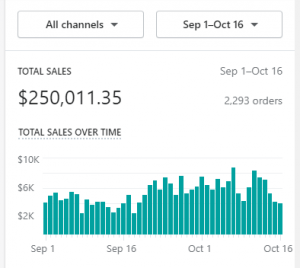
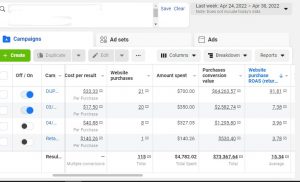
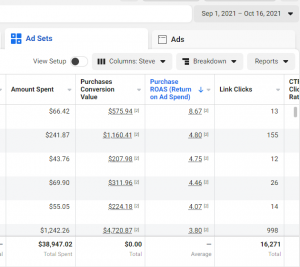
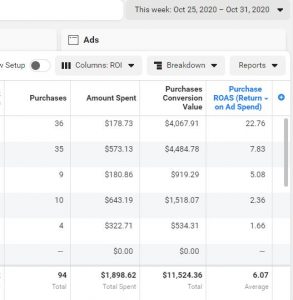
2 – Assessing Potential
These are the things that people often completely ignore when all they are thinking about is scaling their business to $10k, $50k, or $100k+/month. One of my clients really wants to grow in 2022. I’ve asked him a lot of questions to make sure that he is actually ready to do so. When your revenue grows, in most situations so do your problems and so does your workload.
Fulfillment
If you are currently getting 1-3 sales a day in your business and you want to get 10 or 20 a day, can you handle 3x or 10x the amount of work that would take? Unfortunately every client that I’ve worked with THINKS that they have this part handled. They have their ecommerce store on autopilot and just have to do a little bit of spreadsheet work every night or something like that so handling 3x the amount of orders sounds doable in theory. However, we start scaling their store to get 40 sales a day and in come the refunds, customer support emails, hateful comments on the ads, and running out of stock. Or when I’ve generated leads for a local business and their phone is blowing up and they can’t respond fast enough to handle that lead. Or they get a hot lead to call them but their phone is dead, so it goes to voicemail and that lead ends up hiring a competitor who actually answers the phone.
Access To Cash For Testing or Scaling
Two different scenarios here but both have to do with just having money or cash to fund the ad spend and other costs involved in scaling your business. If you are launching a new store and are launching new campaigns, you need to have a source of income coming in to fund the initial testing and optimization that is likely to happen. If you are down to your last $50, don’t put it into a brand new ad account expecting it to turn into $200 overnight. For the scaling situation, you just need to make sure your credit cards don’t have any issues with your payment method in your ad account. This is basic stuff, but you’d be surprised how often I’ve worked with clients who are spending like $500 a day and then they want to spend $1,500 a day, but then their credit card payment fails because they have a limit of $1,000 spend per day for fraud protection and we aren’t able to run ads for 48 hours while they get their account fixed. And also with scaling, take into account any payout delays with your sales to your business bank account to your credit card, etc. If you make a sale on Monday, but don’t get a payout until Saturday, then you need to have cash on hand or credit or whatever to be able to pay for your ad spend from Monday to Friday.
Winning & Validated Product
Pretty self-explanatory that if you don’t have a good product, it won’t sell at scale.
Market Desire
Also self-explanatory if no one wants your product, then ads won’t work. You cannot create desire but you can enhance the desire that someone already has within them.
Size of Market
If there are not enough people who would want to buy your product or service, then there is only so much you can scale it to with profitability.
^ These last 2 points are related directly to each other. Having low market desire can still work if the size of the market is large enough and having a small market size can work if the desire is big enough. This is the concept of having a super small niche of hungry buyers can still be very profitable. The most ideal and probable situation is to have a good amount of market desire and a good market size. Because if one of those factors is heavily inflated, it could probably deflate very quickly. Or if you have 1/10 market desire and a 9/10 market size, if that desire drops from 1 to 0, your business is done.
Store/Website Conversion Rate
When it comes to scaling, your website just needs to be good and functioning properly. It doesn’t matter how good your product is or how hot of a market you have, if your website doesn’t work properly then people won’t buy. If your business has shown potential, then it can be a very good investment to improve your store conversion rate up a percentage point or two. And not only the conversion rate being a factor, but also the traffic capability. Traffic capability probably isn’t a common issue for most websites these days, but just make sure your website doesn’t crash when there are more than 50 people on your site at a time.

Schedule a free 15-Minute Facebook Ads Quick Fix Call with me, and let’s get your results on track!
Ready to get better results with your Facebook Ads?
On the call you will have the opportunity to ask me any questions about your ads and get my feedback about what’s working, what’s not, and what you can do to improve your results.
Click the button below to schedule your Quick Fix Call now!
I’m looking forward to helping you get great results with your Facebook Ads!

Schedule a free 15-Minute Facebook Ads Quick Fix Call with me, and let’s get your results on track!
Ready to get better results with your Facebook Ads?
On the call you will have the opportunity to ask me any questions about your ads and get my feedback about what’s working, what’s not, and what you can do to improve your results.
Click the button below to schedule your Quick Fix Call now!
I’m looking forward to helping you get great results with your Facebook Ads!
3 – Foundations
Now we are actually going to be getting into more detail on what to actually do in your Facebook ad account and touching on scaling foundations. Just like the points above, there aren’t any complete start to finish strategies. These are the things that will heavily vary from one account to the next. That is why you won’t see “Set up a campaign that is $30/day, let it run for 48 hours and if it has a 1.5 ROAS then scale it by 35%, then duplicate the campaign 3x with a 3 new video ads in each ad set…” those are the specifics that you must figure out on your own or have your account audited by an expert who has worked with many ad accounts to point you in the right direction.
Scale Your Best Product First
You want to generate sales sooner rather than later. So you want to launch ads for products that are most likely to get sales for you quickly and easily. That way you have more funds to test elements faster, scale faster, etc. You don’t want to run ads for the product that you WANT to get sales for, do the one that is most likely to get sales. If your best product won’t work with Facebook ads, then chances are none of your products will work until you make some big changes to your brand or marketing strategy.
Effective Data Capturing Mechanism
This is what a lot of people call a “prospecting” campaign, then they fall into the “remarketing” campaign. But what makes a capturing mechanism different from a prospecting campaign is that you set up a campaign with the goal of just filling up your custom audiences with a lot of high quality data. So there are a lot more exclusions and there are ads that are meant to get the smallest engagement (either a click, a like, or a video view) for them to become captured data. I’ll touch on this more in the next point, but when someone sees your ad, you don’t want to rely on them to buy right away. They might not be in the right place or time to buy it. They could be driving or working out at the gym when they see your ad. So you want to capture that data (or person at the gym) with as little effort as possible. If they do as little as click “read more” on your ad, or they watch your video for a few seconds, then that data is captured. As you probably know, retargeting audiences will give you a higher ROAS than a cold audience, but they don’t scale as well. This is how you scale retargeting audiences, you capture data more effectively.
Data Nurturing System
With the data that you capture, you must have a variety in your advertising to properly nurture them towards the buying decision. As mentioned in the last point, you don’t want to rely on someone to buy from your ad the very first time they see it. This is going to vary from brand to brand but there are some brands that get most of their sales after 3 ad impressions from one person, some might be as high as 7, and some might be as low as 1 (heavy impulse buyers). For most brands, their typical “impression to buyer number” is probably gonna be somewhere in that 3-7 range. Let’s just say for example, your “impression to buyer number” is 5. This means your goal is NOT to generate as many impressions as possible, your goal is to generate as many 5th impressions as possible. With all of that being said, you want to have a bit of a variety in your nurturing. Don’t just run the same exact ad to the same person 5 times. Implement a few different creatives, placements, media, etc. This way they are nurtured without experiencing ad fatigue.
Multiple Channels
You want to think of having multiple channels as having systems that catch those sales that “fall through the cracks”. The one channel that I recommend the most is to have email marketing automation systems in your store ASAP. Cart abandonment email, post purchase, etc. I’m not an email marketing expert, but I provide my clients 90 email templates that I purchased for a wide variety of scenarios (cart abandonment, new customer, black friday, etc.) so that they can plug them into their store’s email automation. Another one you can do is run small remarketing campaigns on other platforms. Google Shopping, YouTube, Snapchat, TikTok, etc. this is going to heavily vary from business to business, but I highly recommend getting the email automations in for everybody because it is most likely free and included with your ecommerce store software.
4 – Strategies
This final section could be a post on its own. However, none of it will work without the foundations and mindsets established first.
Analyzing Winning Elements
Scaling in a nutshell can be explained in this sentence: discover winning elements in your marketing strategy and spend more on those elements. There are many things that can be considered an element with Facebook ads. An ad, audience, interest, age range, creative, headline, creative type, and much more. In order to properly analyze and find winning elements, you must perform it similar to a science experiment with the control and the variable. The way you do this is you duplicate everything within a campaign, or ad set, or ad, and just change the one thing you are wanting to test. If you want to test out a 1% lookalike audience, you don’t create a campaign with 1% lookalike with a new video and ad copy. Because if the results are above average or below average, you have no idea what the winning or losing element is in this test because there were too many changed variables in the test.
Monitor Ad Account Behavior
There are many ways to structure a campaign and many settings that you can have on a campaign or ad set or ad. Just to throw a few things out there to establish what I mean: ABO, CBO, dynamic creative, manual bid, narrow interests, etc. In addition to that, ad accounts will respond differently to different budget shifts. Some ad accounts will perform just fine when you double the budget on a campaign, and other ad accounts will perform best with a 20% budget increase every week or so. Some ad accounts perform well with CBO but not with ABO. This is one of the biggest reasons why there is no one size fits all solution for Facebook ads due to some ad accounts being very sensitive to specific setups. Figure out how your ad account responds to certain things and implement future tests, strategies, and campaigns based on your findings.
Controlled vs. Wide Boundaries
This point is closely related to the ad account behavior and is going to adjust from ad account to ad account and from campaign to campaign. In an ideal situation, you could put all of your ads into one campaign, do no targeting, have everything be nice and wide, and set it to $1,000 a day and generate tons of profit. In reality, you have to set some constraints and boundaries. The most common ways people do this is by setting the interest targeting, lookalike targeting, age range, gender, location, and how much budget is spent on each element. When you are scaling, you usually have to put some additional boundaries in for it to properly perform at scale. You might have seen certain campaigns allocate the budget very unevenly. You’ll have 3 ads within an ad set, but Facebook is giving 95% of the ad spend to 1 ad. In most cases, Facebook knows how to allocate budget properly. Think about it, Facebook has seen billions of ads being launched so they have a much better chance of guessing one of your ads will perform best than we would. However you might see that an ad is performing well but is only getting 10% of the budget. In this situation, you might want to take away some of Facebook’s control in order to have an even budget distribution of those ads. For this, I like to set a rule where if an ad spends a certain amount in a day, I’ll have it turned off so that the other ad can get some spend. This also happens often with audiences in a CBO campaign in which you can adjust the Ad Set Spend Limits on the appropriate ad sets.
Monitoring Market Feedback
You never know what is going to work 100% of the time with your Facebook ads. But when the market responds positively to something you launched, that is the most solid evidence of a winning element and it has potential to scale. And when I say feedback, I don’t just mean nice comments or likes or clicks, I mean feedback that generates actual sales and conversions. Pretty self explanatory but people often try to go against the market feedback when they are running ads and scaling. They have an idea and they want their idea to work, but if the market responds poorly to that idea, then don’t scale that.
Analyze Trends More Than The Day To Day
Just because a certain element isn’t performing well today or didn’t perform well yesterday, or the day before, that does not always mean you should turn that off. There is no specific performance or number of days or a rule for implementing this strategy, but here’s a scenario to consider: if you’ve been running a campaign for a couple of weeks and analyzing it for the current week shows that it isn’t performing well, but when you compare THIS week to LAST week you can see that the TREND is going upward. It might be worth leaving that campaign on for another week to see if it continues to trend upward. Maybe Facebook is taking a couple of weeks to properly learn and optimize.
Scaling With New, Similar Products
When you have a winning strategy for one product, it is likely that a similar product that you sell will perform similarly, if not better, using that same winning strategy. This is a good way to launch a new campaign for a similar product without going through the same trial and error that you did for the first product. Use the winning audiences, ad copy style, creative style, and campaign structure.
Scaling With New Offers
This can include a discount, special, or sale for your business. If the offer can generate a lot of desire for your target market, then chances are it will have a very high scaling potential. Might be best to test it with your custom audience first to see how it performs before scaling it to more audiences. For this, put the offer on your best or one of your best products.
Scaling With New, Similar Targeting
If you have a winning element that is tied to an interest or a lookalike audience, you can test out a very similar audience to it. If you have a winning interest that is “health and fitness” then you could try “workout” or “gym” or “nutrition and wellness”. If your best audience is a 2% add to cart Lookalike audience, then you can try a 1% or a 3% or a 2% initiate checkout, etc.
Scaling With New Creatives
The safest way to launch new creatives with success is to do more of what’s already working right now, don’t try and scale a completely new creative out of nowhere. Consider the type of creatives that are winning right now and the style of it. It could be carousel, square images, Instagram story videos, UGC, product photos, etc. This is going to vary from industry to industry so when you hear things like “UGC creatives are the best” take it with a grain of salt and only take into account what is performing with you and your campaigns. So a very simple implementation here, if a certain creative is performing well then create more that are similar to it but slightly different. If your best creative is a UGC video made by a woman, then find another woman to make a UGC video for you. If your best creative is a product photo with a white background, then create a creative that is a product photo with a white background but showing the product from a different angle. The main idea here is to use new creatives in order to prevent ad fatigue and/or recapture attention from your target market.
Conclusion:
If you understand everything in this post, then the specific step-by-step implementations will come naturally and you will be able to scale Facebook ads custom to your situation. I hope this post gives you a better understanding or a better approach when it comes to scaling your Facebook ads.

Schedule a free 15-Minute Facebook Ads Quick Fix Call with me, and let’s get your results on track!
Ready to get better results with your Facebook Ads?
On the call you will have the opportunity to ask me any questions about your ads and get my feedback about what’s working, what’s not, and what you can do to improve your results.
Click the button below to schedule your Quick Fix Call now!
I’m looking forward to helping you get great results with your Facebook Ads!

Schedule a free 15-Minute Facebook Ads Quick Fix Call with me, and let’s get your results on track!
Ready to get better results with your Facebook Ads?
On the call you will have the opportunity to ask me any questions about your ads and get my feedback about what’s working, what’s not, and what you can do to improve your results.
Click the button below to schedule your Quick Fix Call now!
I’m looking forward to helping you get great results with your Facebook Ads!

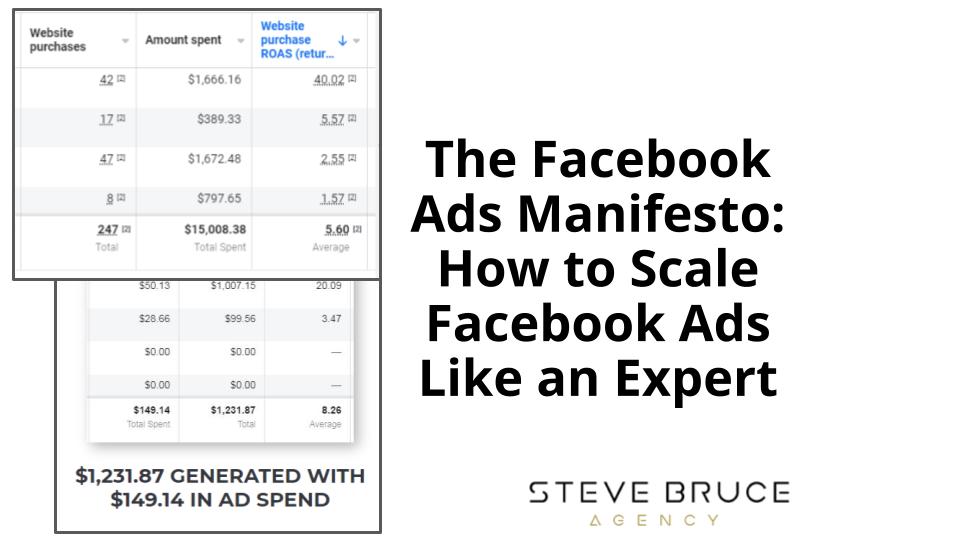
Recent Comments